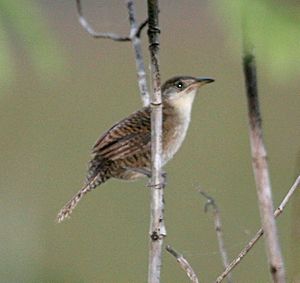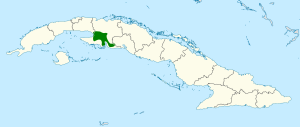Zapata wren facts for kids
Quick facts for kids Zapata wren |
|
|---|---|
 |
|
| Conservation status | |
| Scientific classification | |
| Genus: |
Ferminia
|
| Species: |
cerverai
|
 |
|
The Zapata wren (scientific name: Ferminia cerverai) is a special bird. It is a medium-sized bird with grayish-brown feathers. This wren lives in the thick bushes of the Zapata Swamp in Cuba.
It is the only bird in its group, called a monotypical genus, named Ferminia. This means it's super unique! The Zapata wren is found only in Cuba, which makes it endemic. Sadly, it is also an endangered species. The bird was first officially described in 1926 by a scientist named Thomas Barbour. He named it after Fermín Zanón Cervera, who helped find it.
Contents
What the Zapata Wren Looks Like
The Zapata wren is about 16 centimetres (6.3 in) long. That's about the length of a regular pencil! Its body is mostly brown. It has black stripes and grayish feathers on its belly. The wren also has a long tail.
Its song is loud and high-pitched. People say it sounds like the house wren's song. It's a "musical warble" that starts with a deep sound. The wren sings this in groups of three or four phrases.
Where the Zapata Wren Lives and How We Protect It
The Zapata wren lives only on the Zapata Peninsula in southern Cuba. Its home is usually in freshwater marshes. It also lives in lowland savannas, which are like grasslands with scattered bushes and small trees.
This bird eats many different things. It enjoys insects, spiders, and small snails. It also eats tiny lizards and berries. The Zapata wren usually builds its nest in clumps of sawgrass, which is a type of tough grass. Scientists think they lay their eggs and raise their young between January and July.
The Zapata wren faces several dangers.
- Fires: Fires often happen in the dry season and can destroy their homes.
- Water loss: Draining the wetlands for other uses takes away their habitat.
- Farming: Land is cleared for farming, which also destroys where they live.
- Predators: Animals like mongooses and rats, which were brought to the area by people, hunt the wrens.
How the Zapata Wren Was Discovered
The Zapata wren was officially described by an American scientist named Thomas Barbour. He studied reptiles and amphibians, a field called herpetology. Barbour named the bird cerverai to honor Fermín Zanón Cervera. Cervera was a Spaniard who stayed in Cuba after the Spanish–American War. He became a professional naturalist, someone who studies nature.
Thomas Barbour had traveled with Cervera on trips to Cuba before. When Barbour heard about strange birds in the Zapata area, he asked Cervera to explore the region. After several trips, Cervera finally found the Zapata wren! In Spanish, this bird is simply called ferminia.
See also
In Spanish: Ferminia cerverai para niños


